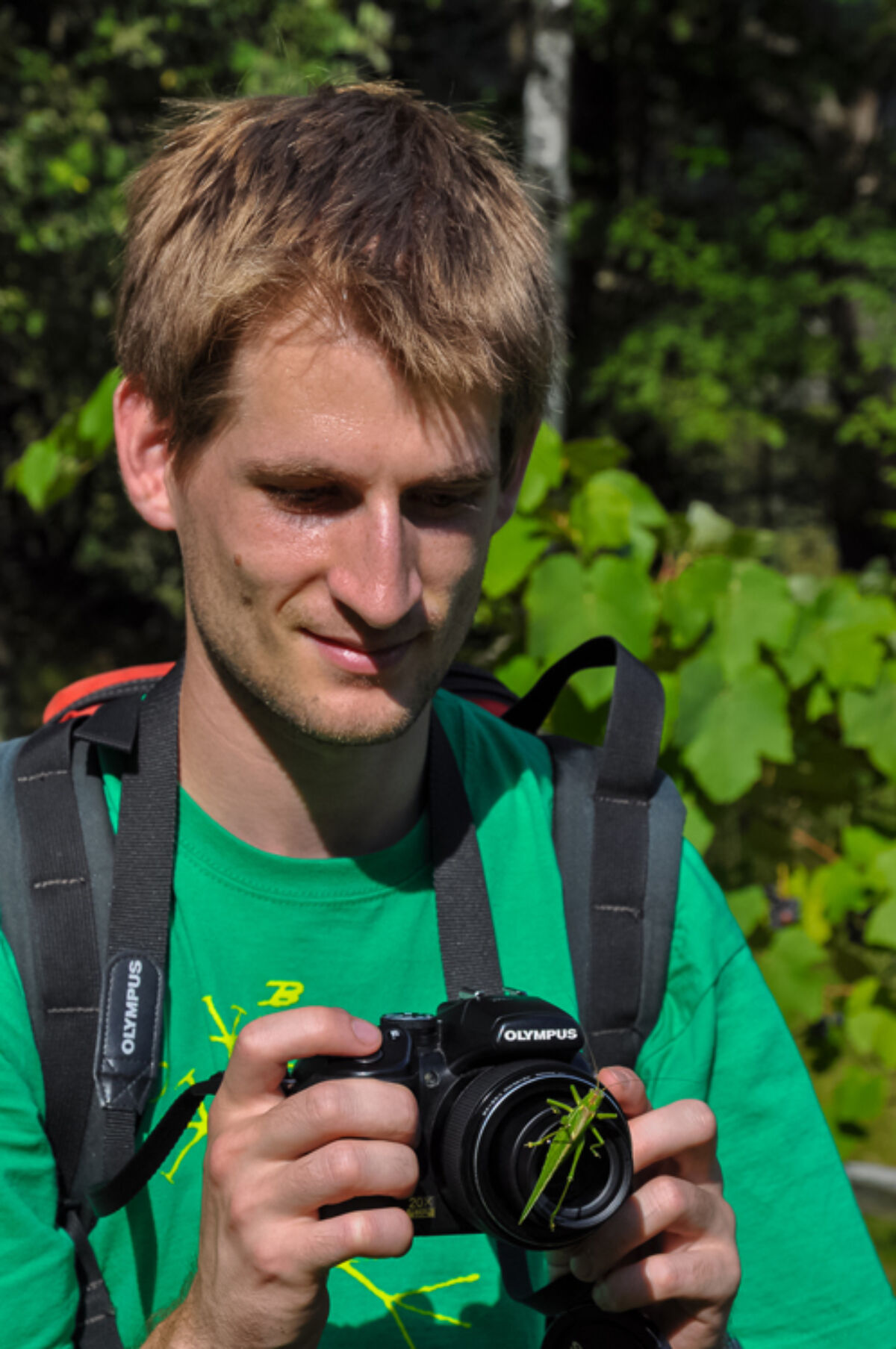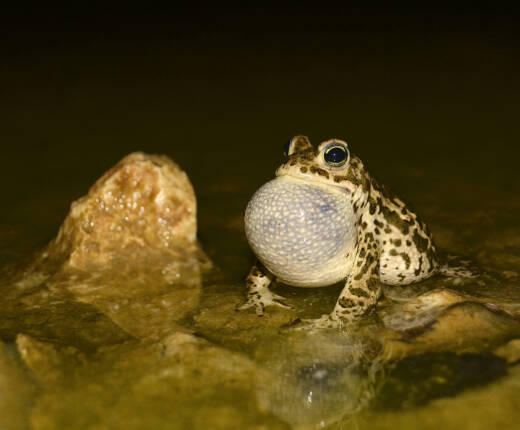Forschungspreis 2015 Space use of natterjack toads in agricultural areas



Die in den beiden Arbeiten angewendeten Methoden haben sich für die Beantwortung der gestellten Forschungsfrage optimal ergänzt und haben ein Maximum an Information geliefert. Für den praktischen Naturschutz in intensiv landwirtschaftlich genutzten Räumen sind die Ergebnisse ermutigend: Auch wenn es an Hotspots in Form von vielfältigen Grubenlebensräumen mangelt, lohnt es sich, eine so anspruchsvolle und gefährdete Art wie die Kreuzkröte mit gezielten Massnahmen im Landwirschaftsgebiet zu fördern. Neu angelegte Laichgewässer und zusätzliche Tagesverstecke stärken die Populationen. Die Befürchtung, dass sich die Gewässer als ökologische Fallen entpuppen, wurde in den vorliegenden Arbeiten zum Glück nicht bestätigt.

Esther Schweizer
Esther Schweizer hat im Rahmen ihres Bachelors an der Zürcher Hochschule für Angewandte Wissenschaften mit einer Telemetriestudie das räumliche Verhalten der Kreuzkröte im Detail erforscht. Sie konnte anhand von 50 adulten besenderten Kreuzkröten bestätigen, dass sich die Art ganzjährig im Landwirtschaftsgebiet aufhält und dabei sowohl Grün- wie auch Ackerland nutzt. Sie konnte ferner zeigen, dass Laichgewässer, Sommerlebensraum und Winterstandort weit auseinander liegen; in drei Fällen wurden Wanderungen von mehr als 1 km registriert. Als Tagesverstecke konnte sie Feldmausgänge, Erdspalten, Bodensenken und Grasbüschel identifizieren, welche offenbar immer in unmittelbarer Nähe zum Ort der nächtlichen Nahrungssuche liegen. Die Habitate hingegen werden hin und wieder gewechselt. Im Sommer graben sich die Tiere in Äckern bis zu 30 cm tief ein, und zur Überwinterung werden besonders gerne sonnige Böschungen mit tiefen Mäusegängen aufgesucht. Erfreulicherweise, aber auch überraschend, konnte unter den besenderten Tieren kein einziger Todesfall infolge der landwirtschaftlichen Nutzung festgestellt werden.
Zusammenfassung der Arbeit (nur in Englisch)
Sand and gravel pits have been the typical secondary habitats for natterjack toads (Epidalea calamita). However, these habitats have become less suitable due to increased sand and gravel production. On the other hand, the endangered species has been observed with increasing frequency reproducing in seasonal ponds or wetlands in agricultural areas. For that reason the Canton of Aargau funded a study to find out if natterjack toads use agricultural areas also as summer and winter habitats. Another goal of the study was to capture the location and extent of the toads’ home ranges as well as to identify the types of habitats and shelters the toads occupy during the different seasons.
A telemetry-study was conducted in the upper valley of the Suhre in the Canton of Aargau, an area dominated by intensive agriculture on clayey soil. A sample of 50 adult male natterjack toads was tagged with external radio transmitters. The location of the toads was checked and recorded, initially daily and then several times a week. A survey of the agricultural area was conducted to identify the available habitats for the toads with regards to type of soil cultivation, vegetation, and their spatial relation.
The study showed that adult natterjack toads indeed use agricultural areas all year round. The summer- and winter habitats were far away from the place of reproduction, at least for the observed population. Their home ranges were identified as areas where the cultivation fields were rather small or formed long stripes. The toads preferred grassland and meadows in spring and fall, yet in summer they tended to prefer ploughed fields. They preferred wheat or corn fields early in the summer and later vegetable- and potato fields. Preferred structures for shelter were mouse holes, crevasses or even small depressions in the soil, tufts of grass or other patchy vegetation. Some toads were found dug in up to 30 cm deep in the soft soil of vegetable or potato fields on hot summer days. For hibernation they chose sunny slopes with deep mouse holes. No casualties or injuries due to agricultural measures have been observed.
Implication for natterjack toad conservation management
The collected data allows the conclusion that agricultural areas are suitable as summer and winter habitat for adult natterjack toads. The species prefers areas with small field sizes and different cultivation fields in close proximity. They avoid entering fields wider than twenty meters. Therefore artificial wetlands introduced as conservation measures should be placed at the convergence of different cultivation fields offering various habitat types for summer residence with nearby sunny slopes where toads can find frost-free soil for hibernation.

Manuel Frei
Manuel Frei hat im Rahmen seiner Masterarbeit an der ETH Zürich und der Eidgenössischen Forschungsanstalt für Wald, Schnee und Landschaft WSL mittels genetischer Methoden die Populationsstruktur und Vernetzung der Laichgewässer erforscht. Anhand des genetischen Fingerabdrucks von 266 erwachsenen Kröten konnte er feststellen, dass die Population des oberen Suhrentals genetisch gut durchmischt ist und dass keines der 11 Vorkommen genetisch isoliert ist. Er konnte auch belegen, dass die Kröten regelmässig zwischen den einzelnen Vorkommen wandern und einzelne Tiere dabei Strecken bis zu 4 km überwinden. Hierbei werden grosse Strassen wie auch die kanalisierte Suhre überquert. Bei der landschaftsgenetischen Analyse hat sich nur der Wald als Barriere herausgestellt, ansonsten scheinen sich die Kreuzkröten im Suhrental weiträumig bewegen zu können.
Zusammenfassung der Arbeit (nur in Englisch)
The Natterjack toad (Epidalea calamita) is a pond-breeding amphibian of open terrains with sparse vegetation. Through the loss of pioneer habitats such as floodplains or extensively managed gravel pits, but also through the intensification of agriculture, the Natterjack toad has become a highly threatened species. In Switzerland, more than 60 % of the known Natterjack-toad occurrences have disappeared in the past 30 years.
Understanding the influence of landscape properties and structure on movement and connectivity of potentially isolated populations is essential for successful conservation management, especially in intensively managed agricultural landscapes. This study assessed the movement, genetic structure and population dynamics of the Natterjack toad in an agricultural landscape of the Suhre valley. Analyses were done by using genetic data derived from microsatellites, radio-tracking data (Schweizer 2013) and census data of population sizes collected within a long-term amphibian monitoring program. In the Suhre valley, situated on the Central Plateau of Switzerland, exist about 20 breeding ponds of the Natterjack toad. Some of them are – surprisingly – located in intensively managed agricultural areas. Are these populations viable or are agricultural areas «ecological traps», i.e. attract toads which then die as a consequence of unsuitable habitat? In other words: should managers invest in extended construction of breeding ponds in agricultural areas to sustain a threatened species?
In total, 19 migration events between populations were detected. The assessment of first-generation migrants from assignment tests uncovered eleven migrants, six migrants could be detected through the unintentional repeated genetic sampling of some individuals and two by radio-tracking. At least five migrants crossed the canalised Suhre river, and seven migration events were observed to cross main roads. So, neither the canalised Suhre river nor main roads seem to be strong barriers for migrating Natterjack toads. The mean distance covered by the 19 migration events was 1500 m with a minimum of 280 m and a maximum of 4200 m.
Accordingly, none of the toad breeding sites was genetically isolated, although there was a trend that built-up areas and roads fostered genetic differentiation in addition to geographical distance. A slight genetic gradient from North to South indicates, that Natterjack toads migrate from the two largest populations in the North and South to smaller breeding ponds in the agriculture area. Analysing the toads as a spatial network supported the inferences that the two largest populations were sources, suggesting that population size may drive the movement pattern of the toad.
The results suggest that the Natterjack toad is well established in the intensely managed agricultural landscape of the Suhre valley. Following conclusions for management are drawn:
- Natterjack toads are able to build viable populations in agricultural landscapes and it is not likely that the investigated agricultural landscape is an ecological trap for Natterjack toads, at least not in situations with abundant ephemeral ponds.
- Conservation priority should also be given to currently large and well-established source populations as the investigated toad network is presumably driven by two populations in the North and South of the study area.




